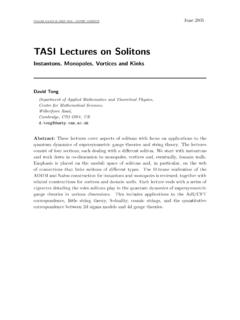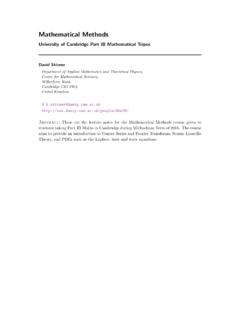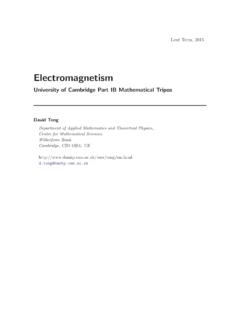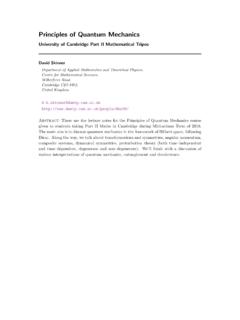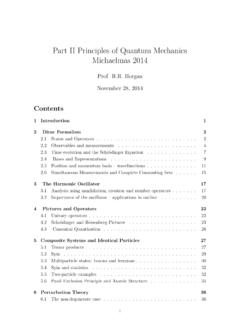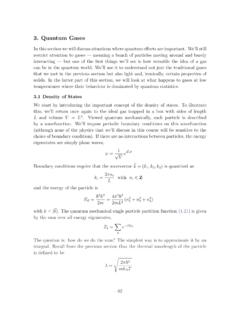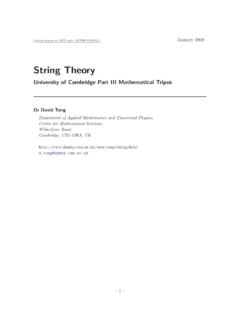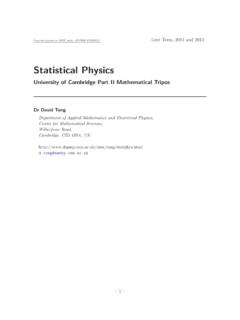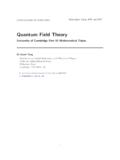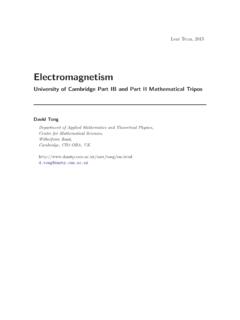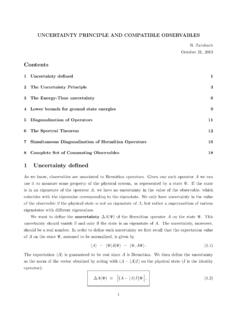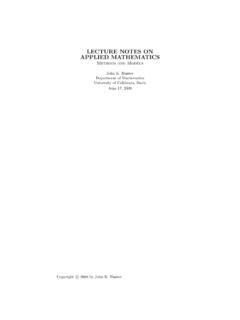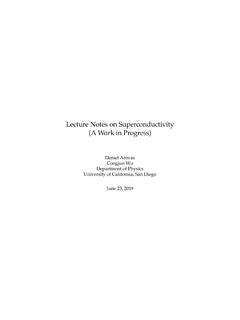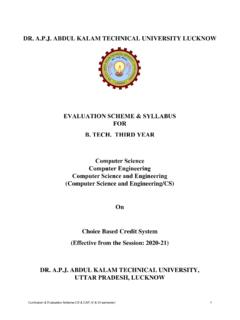Transcription of Classical Dynamics - University of Cambridge
1 Preprint typeset in JHEP style - HYPER VERSIONM ichaelmas Term, 2004 and 2005 Classical DynamicsUniversity of Cambridge Part II Mathematical TriposDr David TongDepartment of Applied Mathematics and Theoretical Physics,Centre for Mathematical Sciences,Wilberforce Road, Cambridge , CB3 OBA, 1 Recommended Books and Resources L. Hand and J. Finch,Analytical MechanicsThis very readable book covers everything in the course at the right level. It is similarto Goldstein s book in its approach but with clearer explanations, albeit at the expenseof less are also three classic texts on the subject H.
2 Goldstein, C. Poole and J. Safko, Classical MechanicsIn previous editions it was known simply as Goldstein and has been the canonicalchoice for generations of students. Although somewhat verbose, it is considered thestandard reference on the subject. Goldstein died and the current, third, edition foundtwo extra authors. L. Landau an E. Lifshitz,MechanicsThis is a gorgeous, concise and elegant summary of the course in 150 content packedpages. Landau is one of the most important physicists of the 20th century and this isthe first volume in a series of ten, considered by him to be the theoretical minimum amount of knowledge required to embark on research in physics.
3 In 30 years, only 43people passed Landau s exam!A little known fact: Landau originally co-authored this book with one of his students,Leonid Pyatigorsky. They subsequently had a falling out and the authorship waschanged. There are rumours that Pyatigorsky got his own back by denouncing Landauto the Soviet authorities, resulting in his arrest. V. I. Arnold,Mathematical Methods of Classical MechanicsArnold presents a more modern mathematical approach to the topics of this course,making connections with the differential geometry of manifolds and forms.
4 It kicks offwith The Universe is an Affine Space and proceeds from Newton s Laws of Mechanics: A Single Mechanics: Many Example92. The Lagrangian Principle of Least Coordinate : Rotating Coordinate : Hyperbolic and Generalised Lagrange (1736-1813) s Theorem and s on a Rotating Body Three Body Kinetic in Electromagnetic Oscillations and : The Double Pendulum41 1 : The Linear Triatomic Molecule423. The Motion of Rigid Ordered Inertia Axis s s Symmetric : The Earth s Asymmetric Top: Asymmetric Top: Poinsot s Euler (1707-1783) Free Symmetric Top Heavy Symmetric the Top Sleeping Precession of the Motion of Deformable The Hamiltonian s Legendre s Conservation Principle of Least s Your Name, Man?
5 William Rowan Hamilton (1805-1865) s Theorem88 2 s Independent e Recurrence Example: Angular Momentum and Example: Magnetic Example: The Motion of Canonical s Theorem Simple Harmonic Variables for 1d Variables for the Kepler Invariants and Liouville s Application: A Particle in a Magnetic s Hamilton-Jacobi and Angles from , Jacobi, Schr odinger and Brackets131 3 AcknowledgementsThese notes rely heavily on the textbooks listed at the beginning and on notes frompast courses given by others, in particular Anne Davis, Gary Gibbons, Robin Hud-son, Michael Peskin and Neil Turok.
6 My thanks also to Michael Efroimsky and MattHeadrick for useful comments. I am supported by the Royal Society. 4 1. Newton s Laws of Motion So few went to hear him, and fewer understood him, that oftimes he did,for want of hearers, read to the walls. He usually stayed about half an hour;when he had no auditors he commonly returned in a quarter of that time. Appraisal of a Cambridge lecturer in Classical mechanics, circa IntroductionThe fundamental principles of Classical mechanics were laid down by Galileo and New-ton in the 16thand 17thcenturies.
7 In 1686, Newton wrote thePrincipiawhere hegave us three laws of motion, one law of gravity and pretended he didn t know cal-culus. Probably the single greatest scientific achievement in history, you might thinkthis pretty much wraps it up for Classical mechanics. And, in a sense, it does. Givena collection of particles, acted upon by a collection of forces, you have to draw a nicediagram, with the particles as points and the forces as arrows. The forces are thenadded up and Newton s famous F=ma is employed to figure out where the par-ticle s velocities are heading next.
8 All you need is enough patience and a big enoughcomputer and you re a modern perspective this is a little unsatisfactory on several levels: it s messyand inelegant; it s hard to deal with problems that involve extended objects rather thanpoint particles; it obscures certain features of Dynamics so that concepts such as chaostheory took over 200 years to discover; and it s not at all clear what the relationship isbetween Newton s Classical laws and quantum purpose of this course is to resolve these issues by presenting new perspectiveson Newton s ideas.
9 We shall describe the advances that took place during the 150years after Newton when the laws of motion were reformulated using more powerfultechniques and ideas developed by some of the giants of mathematical physics: peoplesuch as Euler, Lagrange, Hamilton and Jacobi. This will give us an immediate practicaladvantage, allowing us to solve certain complicated problems with relative ease (thestrange motion of spinning tops is a good example). But, perhaps more importantly,it will provide an elegant viewpoint from which we ll see the profound basic principleswhich underlie Newton s familiar laws of motion.
10 We shall prise open F=ma toreveal the structures and symmetries that lie beneath. 1 Moreover, the formalisms that we ll develop here are the basis forallof fundamentalmodern physics. Every theory of Nature, from electromagnetism and general relativity,to the standard model of particle physics and more speculative pursuits such as stringtheory, is best described in the language we shall develop in this course. The newformalisms that we ll see here also provide the bridge between the Classical world andthe quantum are phenomena in Nature for which these formalisms are not particularlyuseful.
